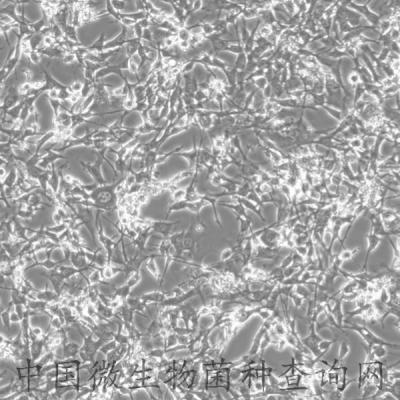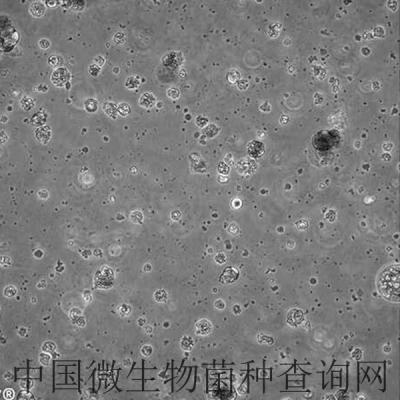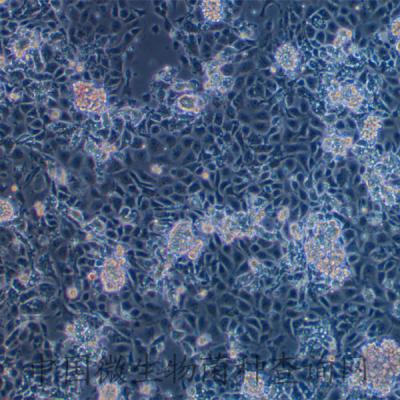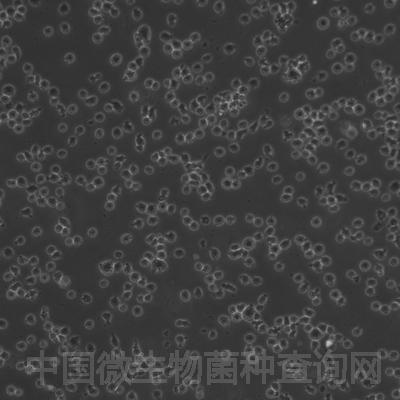
ISE6
CRL-3576 ™
ISE6 is a tick-derived cell line. This product is an ATCC manufactured and accessioned progeny of CRL-11974 cited in US Pat. No. US 5,869,335.
Product category
Animal cells
Organism
Ixodes scapularis
Morphology
Epithelial-like and/or round; neuronal-like
Tissue
Embryo
Applications
Vector-borne disease research
Product format
Frozen
Storage conditions
Vapor phase of liquid nitrogen
General
Specific applications
ISE6 cells may be used to investigate tick- and tick-born pathogens as well as obligate intracellular pathogens. Useful for the growth and study of obligate intracellular bacteria such as those in the genera Rickettsia, Anaplasma, and Ehrlichia. This cell line may also be used to propagate arboviruses and vector-borne flaviviruses (i.e., Semiliki Forest, Hazara, or Langat viruses).
Characteristics
Cells per vial
1.0 x 107
Growth properties
Adherent
Age
embryo
Karyotype
ISE6 cells are have 28 chromosome; 26 autosomes plus 2 sex chromosomes.
Comments
ISE6 cells were isolated from embryonated eggs of the black-legged tick (Ixodes scapularis).
Handling information
Unpacking and storage instructions
Check all containers for leakage or breakage.
Remove the frozen cells from the dry ice packaging and immediately place the cells at a temperature below -130°C, preferably in liquid nitrogen vapor, until ready for use.
Complete medium
The complete medium for this cell line is L15B (see media formulation supplemental data) + 5% heat-inactivated FBS (ATCC 30-2020) + 0.1% Lipoprotein-cholesterol concentrate
ATCC Medium: L-15B
Stock A
CoCl2.5H2O (Sigma, C8661-25G) ………………………………..….. 2 mg
CuSO4.H2O (Sigma C8027-500G) …………………………………… 2 mg
MnSO4.H2O (Sigma M7899-500G) …………………………………. 16 mg
ZnSO4.7H2O (Sigma Z0251-100G) …………………………………. 20 mg
Cell culture grade water (Invitrogen 15230162) …………………… 10 mL
Agitate well at a low speed until the solution becomes clear. After adding 100 µL stock A to Stock D, store in -20°C.
Stock B
Na2MoO4.2H2O (Sigma M1651-100G) ……………………………… 2 mg
Cell culture grade water (Invitrogen 15230162) …………………… 10 mL
Agitate well at a low speed until the solution becomes clear.
After adding 100 µL stock B to Stock D, store in -20°C.
Stock C
Na2SeO3 (Sigma S5261-10G ) ……………………………………… 2 mg
Cell culture grade water (Invitrogen 15230162) …………………… 10 mL
Agitate well at a low speed until the solution becomes clear. After adding 100 µL stock C to Stock D, store in -20°C.
Stock D
Ascorbic acid (Sigma A4403-100MG) …………………………….. 100 mg
Glutathione, reduced (Sigma G6013-5G) ………………………….100 mg
FeSO4.7H2O (Sigma F8633-250G) …………………………………... 5 mg
Cell culture grade water (Invitrogen 15230162) …………………… 9.7 mL
Stock A …………………………………………………………………. 100 µL
Stock B …………………………………………………………………. 100 µL
Stock C …………………………………………………………………. 100 µL
Add components listed above in order. For example, after 100 mg Ascorbic acid is dissolved, add 100 mg Glutathione. Add 5mg FeSO4.7H2O after Glutathione is dissolved. Once all of these components are dissolved well, combine this solution and 100 µL Stock A, 100 µL Stock B, 100 µL Stock C lastly to make 10 mL Stock D. After adding 1 mL Stock D into 1 L of L-15B, store at -20°C.
* Note: FeSO4.7H2O is light sensitive and rapidly oxidized by heat.
Stock E
p-aminobenzoic acid (Sigma A9878) ………………………….……. 10 mg
Cyanocobalamine (B12) (Sigma V6629-250MG) …………………... 5 mg
d-Biotin (Sigma B4639-100MG) ……………………………………….1 mg
Cell culture grade water (Invitrogen 15230162) ………….………… 10 mL
Agitate well at a low speed until the solution becomes clear. After adding 1 mL Stock E into 1 L of L-15B, store in -20°C.
Final product L-15B
L-15 powder (Gibco 41300039) ………………………………… 1 pkg (1 package)
L-aspartic acid (Sigma A7219-100G) ……………………………. 0.299 g
L-glutamine (Sigma G8540-25G) ………………………………….0.292 g
L-proline (Sigma P5607-25G……………………………………… 0.300 g
L-glutamic acid (Sigma G8415-100G) …………………………… 0.490 g
a-ketoglutaric acid (Sigma K1128-5G) …………………………… 0.299 g
D-glucose (Sigma G7021-100G) …………………………………..14.41 g
Stock D ………………………………………………………………. 1.0 mL
Stock E ………………………………………………………………. 1.0 mL
Cell culture grade water (Invitrogen 15230162) ………….………700 mL (Final 1000 mL)
*Note: Use fresh L-glutamic acid: expired in 1 year at 4 °C
*Note: Stir slowly until all components are dissolved well without heating (< 1 hr). While stirring, protect the media from light.
Adjust pH to 7.2 by adding 10N NaOH (~0.5 mL).
Bring the volume up to 1L with Cell culture grade water.
Filter the media with 0.22 µm aPES filter unit. Aliquot 500 mL and store at 4 °C. Media expires 6 months from preparation date or the expiration date of the shortest shelf life component.
Temperature
30-34°C
Atmosphere
100% Air
Handling procedure
Handling Procedure for Frozen Cells
To insure the highest level of viability, thaw the vial and initiate the culture as soon as possible upon receipt. If upon arrival, continued storage of the frozen culture is necessary, it should be stored in liquid nitrogen vapor phase and not at -70°C. Storage at -70°C will result in loss of viability.
SAFETY PRECAUTION: ATCC highly recommends that protective gloves and clothing always be used and a full face mask always be worn when handling frozen vials. It is important to note that some vials leak when submersed in liquid nitrogen and will slowly fill with liquid nitrogen. Upon thawing, the conversion of the liquid nitrogen back to its gas phase may result in the vessel exploding or blowing off its cap with dangerous force creating flying debris.
1. Thaw the vial by gentle agitation in a 37°C water bath. To reduce the possibility of contamination, keep the O-ring and cap out of the water. Thawing should be rapid (approximately 2 minutes).
2. Remove the vial from the water bath as soon as the contents are thawed, and decontaminate by dipping in or spraying with 70% ethanol. All of the operations from this point on should be carried out under strict aseptic conditions.
3. Transfer the vial contents to a centrifuge tube containing 9.0 ml complete culture medium and spin at approximately 125 xg for 5 to7 minutes.
4. Resuspend cell pellet with the recommended complete medium (see the specific batch information for the culture recommended dilution ratio) and dispense into a 25 cm2 or a 75 cm2 culture flask. It is important to avoid excessive alkalinity of the medium during recovery of the cells. It is suggested that, prior to the addition of the vial contents, the culture vessel containing the complete growth medium be placed into the incubator for at least 15 minutes to allow the medium to reach its normal pH (7.0 to 7.6).
5. Incubate the culture at 31°C in a suitable incubator. A free gas exchange with atmospheric air is recommended if using the medium described on this product.
Subculturing procedure
Volumes used in this protocol are for non-vented(plug cap) 75 cm2 flask; proportionally reduce or increase amount of dissociation medium for culture vessels of other sizes. Corning® Plug seal cap T-75 flasks (catalog #430720U) are recommended for subculturing this product.
Do not use trypsin to detach cells. At the time of subculture, the medium in the culture flask should first be replaced with fresh culture medium.
Tapping the flask may work if cells are loosely attached. The cells are then flushed off the growth surface using a serological pipette to direct a stream of medium at the cell layer until all have been detached.
Once collected, detached cells can be counted and seed into a new flask at appropriate seeding density without centrifugation.
It is recommended to subculture once a week. Do not change media before 7 days. If cells are not ready for subculture at Day 7, media change should be performed. If cells appear to be detached the day following the media change, collect and centrifuge the floating cells and proceed with subculture as previously described. Combine cell pellet from the floating cells with the collected adherent cells before performing a cell count.
Add appropriate aliquots of the cell suspension to new culture vessels.
Cultures can be established between 2.0 x 1054 and 4.06.0 x 105 viable cells/cm2.
Incubate cultures at 32.0°C.
Interval: Maintain cultures at a cell concentration between 1.0 X 1054 and 5.0 X 105 cell/cm2.
Subcultivation Ratio: A subcultivation ratio of 1:2 to 1:68 is recommended
Medium Renewal: Once per week
Reagents for cryopreservation
Complete culture medium + 5% DMSO (ATCC 4-X)
Quality control specifications
Bacterial and fungal testing
Not detected
Mycoplasma contamination
Not detected
History
Deposited as
ATCC accessioned progeny of ISE6 Tick cell line cited in US Pat. No. US 5,869,335 as CRL-11974.
Legal disclaimers
Intended use
This product is intended for laboratory research use only. It is not intended for any animal or human therapeutic use, any human or animal consumption, or any diagnostic use.
Warranty
The product is provided 'AS IS' and the viability of ATCC® products is warranted for 30 days from the date of shipment, provided that the customer has stored and handled the product according to the information included on the product information sheet, website, and Certificate of Analysis. For living cultures, ATCC lists the media formulation and reagents that have been found to be effective for the product. While other unspecified media and reagents may also produce satisfactory results, a change in the ATCC and/or depositor-recommended protocols may affect the recovery, growth, and/or function of the product. If an alternative medium formulation or reagent is used, the ATCC warranty for viability is no longer valid. Except as expressly set forth herein, no other warranties of any kind are provided, express or implied, including, but not limited to, any implied warranties of merchantability, fitness for a particular purpose, manufacture according to cGMP standards, typicality, safety, accuracy, and/or noninfringement.
Disclaimers
This product is intended for laboratory research use only. It is not intended for any animal or human therapeutic use, any human or animal consumption, or any diagnostic use. Any proposed commercial use is prohibited without a license from ATCC.
While ATCC uses reasonable efforts to include accurate and up-to-date information on this product sheet, ATCC makes no warranties or representations as to its accuracy. Citations from scientific literature and patents are provided for informational purposes only. ATCC does not warrant that such information has been confirmed to be accurate or complete and the customer bears the sole responsibility of confirming the accuracy and completeness of any such information.
This product is sent on the condition that the customer is responsible for and assumes all risk and responsibility in connection with the receipt, handling, storage, disposal, and use of the ATCC product including without limitation taking all appropriate safety and handling precautions to minimize health or environmental risk. As a condition of receiving the material, the customer agrees that any activity undertaken with the ATCC product and any progeny or modifications will be conducted in compliance with all applicable laws, regulations, and guidelines. This product is provided 'AS IS' with no representations or warranties whatsoever except as expressly set forth herein and in no event shall ATCC, its parents, subsidiaries, directors, officers, agents, employees, assigns, successors, and affiliates be liable for indirect, special, incidental, or consequential damages of any kind in connection with or arising out of the customer's use of the product. While reasonable effort is made to ensure authenticity and reliability of materials on deposit, ATCC is not liable for damages arising from the misidentification or misrepresentation of such materials.





